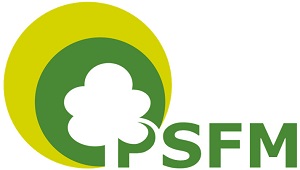XÁC ĐỊNH MỨC THÍCH NGHI CỦA LÀM GIÀU RỪNG KHỘP BẰNG CÂY TẾCH (Tectona grandis L.f.) THEO CÁC NHÂN TỐ QUAN TRẮC TRỰC TIẾP VÀ THỰC VẬT CHỈ THỊ
Từ khóa:
Cây tếch, làm giàu rừng,, mức thích nghi, rừng khộp, thực vật chỉ thịTóm tắt
Sau nhiều năm khai thác gỗ không bền vững, rừng khộp (rừng khô rụng lá cây họ Dầu ưu thế) đã trở nên nghèo về gỗ và từ đó nhiều diện tích đã được chuyển đổi thành các loại cây công nghiệp như cao su. Mục tiêu của nghiên cứu này là đánh giá việc trồng cây gỗ Tếch (Tectona grandis L.f.) trong điều kiện rừng khộp suy thoái và xác định các nhân tố quan sát trực tiếp ảnh hưởng đến sự thích nghi của cây Tếch trong làm giàu rừng khộp. 42 ô thí nghiệm với diện tích 4.900m2 (bao gồm 64 ô sinh thái) đã được thiết lập và được quan sát trong 4 đến 5 năm để thử nghiệm việc làm giàu rừng khộp bằng cây Tếch theo các tổ hợp các nhân tố khác nhau. Mô hình hồi quy đa biến, phi tuyến, có trọng số đã được sử dụng để phát hiện các nhân tố chính ảnh hưởng đến sụ thích nghi của cây Tếch. Kết quả là trong các điều kiện môi trường sinh thái khắc nghiệt của rừng khộp, trồng bổ sung bằng cây gỗ Tếch đã cho kết quả đầy hứa hẹn với bốn mức độ thích nghi; và kết quả cũng cho thấy rằng bốn nhân tố quan sát trực tiếp ảnh hưởng đến mức thích nghi của cây Tếch là ngập úng trong mùa mưa; sự hiện diện của loài Cỏ lào (Eupatorium odoratum L.) chỉ thị cho tiềm năng tăng trưởng của gỗ Tếch; tỷ lệ phần trăm kết von trên mặt đất rừng và các loài cây rừng khộp ưu thế.
Tài liệu tham khảo
1. Adjers G, Hadengganan S, Kuusipalo J, Nuryanto K, Vesa L. 1995. Enrichment planting of dipterocarps in logged - over secondary forests: effect of width, direction and maintenance method of planting line on selected Shorea species. Forest Ecology and Management, volume 73, issuses 1 - 3(1995): 259 - 270
2. Appanah S, Turnbull JM. 1998. A Review of Dipterocarp: Taxonomy, ecology and silviculture. Center for International Forestry Research (CIFOR). ISBN 979 - 8764 - 20 - X.
3. Appanah S. 1998. Management of Natural Forests. In: (eds) Appanah S, Turnbull JM. 1998. A Review of Dipterocarp: Taxonomy, ecology and silviculture. Center for International Forestry Research (CIFOR). ISBN 979 - 8764 - 20 - X. p130 - 149.
4. Bảo Huy, 1995. Sinh trưởng và sản lượng rừng trồng Tếch tại Đắk Lắk. Kỷ yếu Hội thảo quốc gia lần thứ nhất về trồng rừng Tếch ở Việt Nam, Hội Khoa học Kỹ thuật Lâm nghiệp Việt Nam, tr. 71 - 78.
5. Bảo Huy, Nguyễn Văn Hòa, Nguyễn Thị Kim Liên, 1998. Nghiên cứu các cơ sở khoa học để kinh doanh rừng trồng Tếch ở Tây Nguyên. Báo cáo khoa học đề tài cấp bộ trọng điểm, Bộ Giáo Dục và Đào tạo.
6. Behaghel, I. 1999. The state of Teak (Tectona grandis L.F.) plantations in the world. Bois et Forêst Des Tropiques, 262(4): 18 - 58.
7. Bộ Nông nghiệp và PTNT, 2009. Thông tư số 34/2009/TT - BNNPTNT của Bộ Nông nghiệp và PTNT, ban hành ngày 10/06/2009: Quy định tiêu chí xác định và phân loại rừng.
8. Kaosa - ard A. 1998. Management of Teak Plantations - Overview of problems in teak plantation establishment. Forest Resources Department, Chiang Mai University, Thailand. RAP Publication - 1998/05, 249 pp, AC773/E.
9. Kollert W and Cherubini L. 2012. Teak resources and market assessment 2010, FAO Planted Forests and Trees Working Paper FP/47/E, Rome, Available at http://www.fao.org/forestry/plantedforests/67508@170537/en/.
10. Ladrack W. 2009. Management of teak plantations for solid wood products. International Society of Tropical Foresters (ISTF) News. Special report,December, 2009. 5400 Grosvenor Lane, Bethesda, Maryland 20814, USA. Mallows, C.L., 1973. Some Comments on CP. Technometrics 15 (4): 661 - 675. doi:10.2307/1267380. JSTOR 1267380.
11. Mallows, C.L., 1973. Some Comments on CP. Technometrics 15 (4): 661 - 675. doi:10.2307/1267380. JSTOR 1267380.
12. Maury - Lechon G, Curtet L. 1998. Biogeography and Evolutionary Systematics of Dipterocarpaceae. In: (eds) Appanah S, Turnbull JM. 1998. A Review of Dipterocarp: Taxonomy, ecology and silviculture. Center for
International Forestry Research (CIFOR). ISBN 979 - 8764 - 20 - X. p5 - 44.
13. Mayer DG, Butler DG. 1993. Statistical validation. Ecological Modelling, 68(1993): 21 - 32.
14. Pandey D, Brown C. 2000. Teak: a global review. Unasylva, Vol. 51 - 2000/2
15. Paquette AJ, Hawryshyn A, Senikas V, and Potvin C. 2009. Enrichment planting in secondary forests: a promising clean development mechanism to increase terrestrial carbon sinks. Ecology and Society 14(1): 31. Available at
http://www.ecologyandsociety.org /vol14/iss1/art31/
16. Picard N, Saint - André L, Henry M. 2012. Manual for building tree volume and biomass allometric equations: from field measurement to prediction. Food and Agricultural Organization of the United Nations, Rome, and Centre de Coopération Internationale en Recherche Agronomique pour le Développement, Montpellier, 215 pp.
17. Roshetko JM, Rohadi D, Perdana A, Sabastian G, Nuryartono N, Pramono AA, Widyani N, Manalu P, Fauzi MA, Sumardamto P, Kusumowardhani N. 2013. Teak agroforestry systems for livelihood enhancement, industrial timber production, and environmental rehabilitation. Forests, Trees and Livelihoods, 22:4, 241 - 256,
DOI: 10.1080/14728028.2013.855150
18. Saint - André L, M'bou AT, Mabiala A, Mouvondy W, Jourdan C, Rouspard O, Deleporte P, Hamel O. & Nouvellon Y. 2005. Age - related equations for above and below ground biomass of a Eucalyptus hybrid in
Congo. Forest Ecology and Management, 205, 199 - 214.
19. Weaver PL 1993. Tectona grandis L.f. Teak. Verbenaceae, Verbena family. SO - ITF - SM - 64
20. Wyatt - Smith J. 1963. Manual of Malayan silviculture for inland forests. Malayan Forest Record No. 23. Forest Department, Kuala Lumpur.












